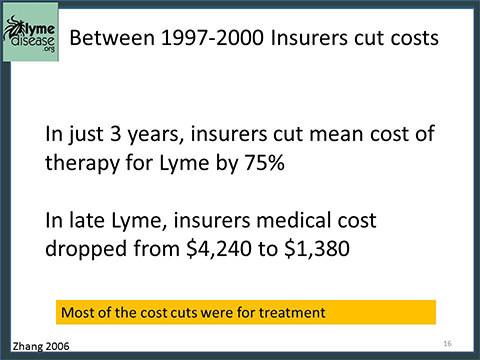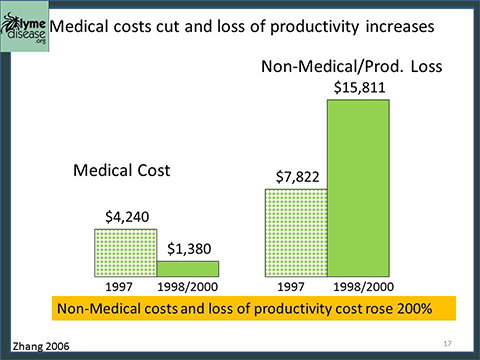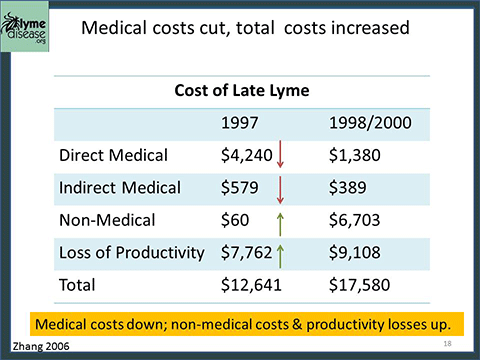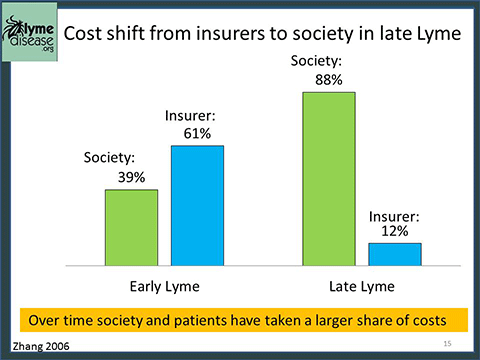LYMEPOLICYWONK: MA insurance bill hearing–how insurers cut costs at the expense of patients

Yesterday, patient advocates testified before the Joint Committee on Financial Services for a bill (H. 989) that would require insurance companies to cover antibiotic treatment for Lyme as prescribed by a physician. LymeDisease.org submitted a chart book as testimony. Drawing on our survey results and a key cost of illness study by Dr. Zhang of the Centers for Disease Control and Prevention, our submission tells the story of how medical costs by insurers have been cut 75% while costs borne by patients, their families, society, and public governments for loss of productivity have increased 200%.
Zhang’s study explains that during the period of his study insurers cut costs over a 3 year period. For late Lyme they reduced the mean costs from $4,424 to $1,380. The costs of diagnostic tests and so forth remained relatively stable, but treatment costs decreased. There are many ways of cutting costs, but the one patients complain about the most is a flat out denial of care beyond 4 weeks of treatment. Denials of coverage are widely reported by patients with late Lyme and even those with early Lyme who require treatment beyond 4 weeks. Patients, of course, can appeal these denials, but, the fact is, they rarely win. In states where independent medical reviews have been evaluated, less than 10% of patient appeals succeed (compared to 50% or more for other conditions).
Our surveys have found that at some point in their illness 65% of patients have had to cut back or quit school or work due to Lyme disease, and 25% of those with Lyme disease were forced to go on disability at some point in their illness. When patients leave the workforce or cut back on work or take days off of work, this increases costs due to loss of productivity. Patients are also responsible for non-medical cost, like care in the home. From Zhang’s study we know that while insurers cut their costs, patient’s non-medical costs and costs due to loss of productivity increased by 200%.
When denying care increases the burden on society, it’s time to recognize that insurers are essentially dodging their obligation to provide care and leaving society holding the bill. The table below lays out the full story of how the cost shift occurred. Specifically, medical costs (primarily for treatment) for late Lyme were reduced from $4,240 to $1,380. But these costs cuts were more than offset by a 200% increase in non-medical costs and loss of productivity costs. These costs increased from roughly $8,000 to $16,000. The result is that the total costs of disease went up, but the proportion of the expenses borne by insurers went down.
In late Lyme disease the average annual costs, exceeds $20,000 (as adjusted for inflation to 2012 dollars). Insurers bear just 12% of these costs, while patients bear the remaining 88%. Loss of productivity, when patients aren’t able to work, is the lion’s share of this—a staggering 54%.
It’s easy to cut medical costs—all you have to do is deny care. But if denying care means more people become unemployed or are forced to go on disability, then that is a trade-off that works well for insurers but harms the public.
For patients, the increased burden of having to cut back on work and arrange for care in the home can have devastating financial consequences. For governments, these lost wages mean reduced taxes and, in the case of disability, increased costs for public support of patients who are unable to work. The annual cost of late Lyme is a recurring cost until the underlying problem is addressed and patients are restored to their productive lives. Turning a blind eye to patient suffering by denying care is not only inhumane, it is costly. We believe it’s time to ask the insurers to start paying their fair share.
A hard copy of this post to share with legislators and other policy makers can be downloaded. Chart book 11.14.13 FINAL with correction
The LYME POLICY WONK blog is written by Lorraine Johnson, JD, MBA, who is the Chief Executive Officer of LymeDisease.org, formerly CALDA. Contact her at lbjohnson@lymefaces.com. On Twitter, follow me @lymepolicywonk.
Resources:
I explored this topic in my “Financial Burden of Lyme Disease” Presentation at Gibson Forum.
Johnson L, Aylward A, Stricker RB. Healthcare access and burden of care for patients with Lyme disease: a large United States survey. Health Policy. 2011 Sep;102(1):64-71. Available from: http://www.ncbi.nlm.nih.gov/pubmed/21676482
Zhang X, Meltzer MI, Pena CA, Hopkins AB, Wroth L, Fix AD. Economic impact of Lyme disease. Emerging infectious diseases. 2006 Apr;12(4):653-60. (Zhang’s costs are based on the year 2002. [Zhang’s costs are adjusted for inflation through 2002. The $20,000 number I cite for the cost of late Lyme inflation adjusts his number through 2012.]
See my blogs on the topic of cost of illness and Lyme disease:
Is an ounce of prevention worth a pound of cure?
Annual Lyme costs now top 3.1 Billion—Time to wake up!
THE COST OF DENIAL—THE DOLLARS AND SENSE OF IT












Kudos, Lorraine. Words can’t adequately express how much I admire your work. Thanks for all you do.
I am wishing this could go nationwide ASAP and that the Obama’s would get on the bandwagon to make the insurance companies stop harassing the doctors who are trying to help us. The people with HIV/AIDS were finally treated with respect, why aren’t we??? I live in VA, probably picked up the tick in WA State, don’t know, never had the rash, never had any indication of infection except the feeling that my body was shutting down, and wanted to die. Lucky I had my family doctor who started me on antibiotics before the blood work came back. I think my Lyme and co-infections were discovered and treated soon enough, not everyone is so lucky.
I had all the symptoms, rash included . The doctors I saw both in Seattle and Florida did not recognize the symptoms. Doctor education is the answer.would save a lot of money and grief.